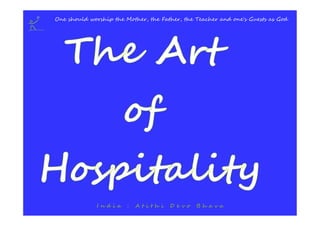Responsible Tourism - The art of hospitality: India - Atithi Devo Bhava
- 1. One should worship the Mother, the Father, the Teacher and one's Guests as God In dia : At it hi De vo Bha va
- 2. In ancient times, when means of communication were limitedĪŁ
- 3. and it was not possible for guests to anticipate their date of arrival, ĪŁ
- 4. A T I T H I was coined to depict a visiting person who had no fixed date of arrival or departure.
- 5. D E V O means God and B H A V means Be/Is,
- 6. literally meaningĪŁ ?Guest is GodĪ░.
- 7. In Hinduism G O D is worshipped in 5 Step worship
- 8. These five steps are Dhoop : fragrance Deep : lamp Naivaidya : edibles Akshat : rice Pushp : flower
- 9. ?Shodashopchar PoojanĪ░ is an elaboration and formalisation of this ritual.
- 10. FRA G RA N CE While receiving guests we must see that rooms have a pleasant fragrance, because this is the first thing that attracts guests or detracts from their visit. A pleasant fragrance will put your guest in good humour.
- 11. LAM P Prior to the electrification of India, a lamp was put between host and guest so that expression and body language remain clearly visible and there is no gap between host and guest.
- 12. EDIBLES Fruits and sweets made of milk are offered to guests.
- 13. RICE It is a symbol of being undivided. A tilak made of a vermilion past is put on forehead and rice grains are placed on it. This is the highest form of welcome in Hindu Indian families.
- 14. FLOWER Offering a flower has always remained a gesture of goodwill since the dawn of civilization. When the guest departs, the flower symbolizes the sweet memories of his visit that haunt him for several days.
- 15. In India this art of hospitality is called Atithi Devo Bhava respontour - responsible tourism - communication - PR - representation www.respontour.net contact@respontour.net















